Planning ecommerce architecture is as important as planning a building block. Fail to draw up a detailed blueprint for your house, and you’ll see it collapse in a couple of years.
The same happens with your ecommerce website. In the 13+ years that Elogic has been in the market, we’ve seen clients come to us for mere performance optimization and leave with the whole ecommerce website revamp because their legacy architecture was the #1 reason for poor business growth.
Your online shop architecture should concern both back-end and front-end that secure scalability and flexibility of your website. But it also relates to the system of search and information you organize for better consumer experiences. And oftentimes, retailers struggle balancing these two aspects.
In this article, you’ll learn why the technical architecture of an ecommerce website should be well-thought-out before your website is built, which architecture might be the best fit for your business, and who can get it done for you.
We’ll also share a few architecture diagrams for ecommerce websites, so read on!
What Is Ecommerce Architecture and Why Do You Need a Good One?
Ecommerce website architecture has two definitions:
- It relates to the technical structure behind your ecommerce store and the way in which your website presentation, business, and data layers interact with one another.
- It is a form of arrangement of the information that’s presented on the website that defines a hierarchy of how the data blocks relate to each other.
In layman’s terms, ecommerce site architecture is its underlying structure or a framework that allows your business to grow, stay visible online, and provide the outstanding user experience (UX) all retailers strive for.
Why is having a smoothly working ecommerce architecture design a must?
- It helps search engines (SE) to index the website and rank it higher. SE operating logic depends immensely on structures and their connectivity. So to allow easy crawling and indexing, the target website should be organized in a scannable way.
- It allows for scalability. Depending on the language and tools used, you may not need to create the website from the ground up — you can upgrade and add functions to the existing one. But it is only possible if you know which parts and structures of the websites will be affected by the change.
- It enables easy third-party integrations. Just like with the example above, knowing the links and connections in your ecommerce software architecture will help you with powering your software with the solutions offered by many vendors, so you can deliver a better user experience.
- It enhances the user experience. Apart from adding new useful features, a detailed ecommerce project architecture simplifies the use of the website. Navigation menu, breadcrumbs, sitemap, internal linking — all that should encourage the customer to stay on your website and surf through it without the feeling of getting lost.
The person who plans the ecommerce technical architecture is called a solution architect and has to be involved in the website planning process from day one. Discussing the website architecture prior to developing the site will prevent you from extra-budget expenses, unforeseen code conflicts, and a waste of money for what could’ve been adjusted or improved without deleting it.
Find one in a large pool of talented engineers at Elogic and plan your site architecture to a tee
Hire a solution architectCurrent practices feature three types of architecture for ecommerce website. Below we explain their peculiarities, provide ecommerce architecture diagram for each type, and outline their pros and cons.
Ecommerce Architecture: Two-Tier Architecture
Two-tier website architecture implies that there are two sides of the architecture for the client domain and the business database domain. They exist in constant interaction.
For example, the user retrieves the information stored in the database or sends their data to be stored there (i.e., account or billing details), thus making the database respond to the request to provide or process the data. And it’s because of the well-planned ecommerce website architecture design that such real-time communication is possible.
Your two-tier ecommerce website architecture diagram will look like this:

The two-tier architecture is commonly used for homogeneous environments as it contains static business rules. It’s also the most preferred option for startups that want to validate the hypothesis prior to spending lots of money on a full-scale platform. However, it also has certain limitations.
| Pros of two-tier architecture | Cons of two-tier architecture |
| — Simple, fast, and cheap to develop and deploy | — Not suitable for heterogeneous environments, as changing the business logic often will bring down the performance |
| — Allows for accurate and fast prototyping | — Allows for a limited number of users and isn’t scalable |
| — Database server and business logic are close, which enhances performance | — It has low control and re-distribution level since usually the client-side has most of the application logic |
| — It’s complicated to change the database structure if needed due to mutually dependent components and monolithic code |
Ecommerce Architecture: Three-Tier Architecture
In three-tier eCommerce architecture, in addition to client and database, there is an extra middle layer, a server-side. This forms three layers of the architecture:
- Presentation layer (client)
- Application layer (business logic)
- Database layer (database)
One of the biggest distinctions in this type of architecture is that each layer functions independently, runs on different servers, and is treated as a separate module when it comes to its development, modification, or maintenance.
Here’s what a three-tier online shopping architecture diagram looks like.
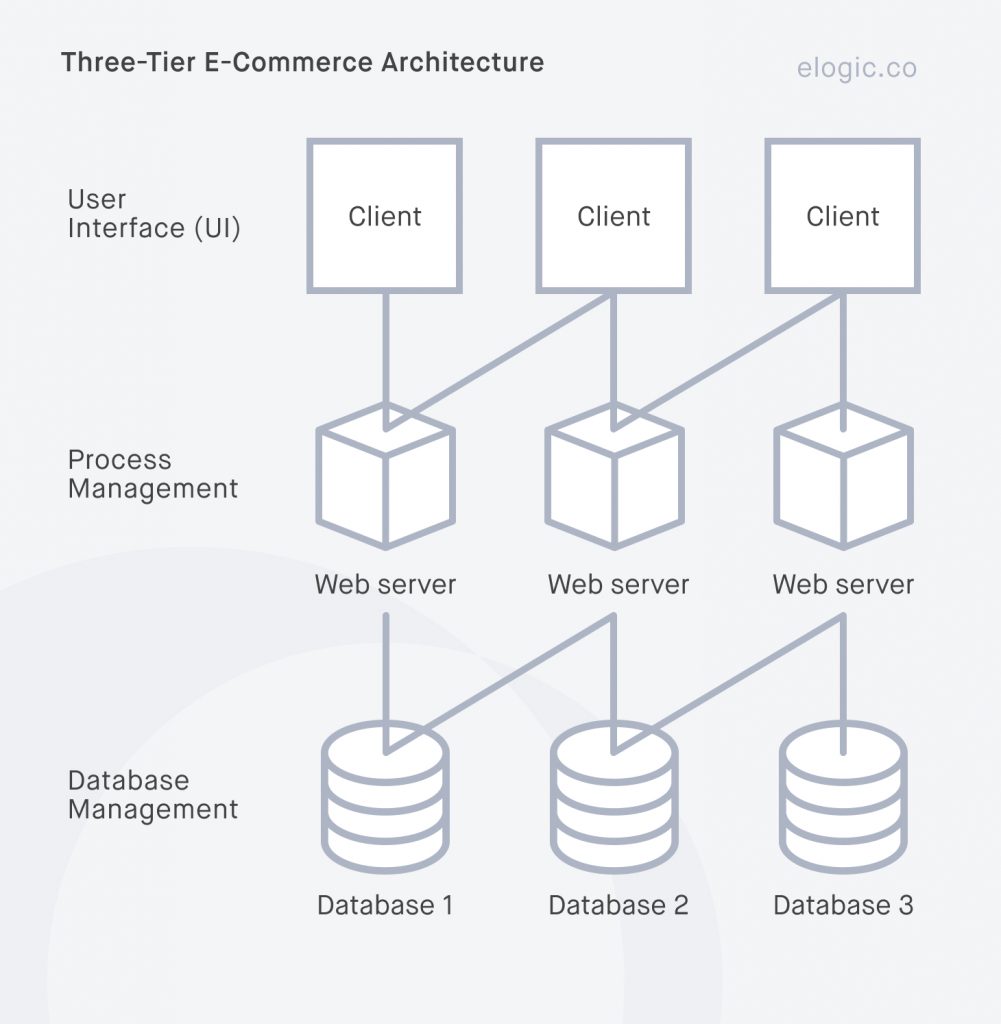
This is a must-have architecture type for large-scale enterprises that target multiple users, but it also has its disadvantages you need to consider.
| Pros of three-tier architecture | Cons of three-tier architecture |
| — Improved scalability due to better synchronization between the modules | — Complex communication between layers, which makes the implementation difficult |
| — Enhanced security level as there’s no direct interaction with data from the database | — It requires more manual management since there are fewer automated tools to process the content |
| — Possible partial updates without affecting the whole ecommerce system architecture | |
| — Availability even if the server is down due to cache data. |
Following the logic of three-tier ecommerce architecture, there’s a type called “n-tier architecture”. In this case, multiple servers between the client layer and database layer balance the data distribution and ensure decentralization.
This type has all the advantages of the three-tier architecture but also multiplies its cons, meaning that it’s harder and more expensive to maintain flawless communication between the components of ecommerce architecture and test it.
Ecommerce Microservices Architecture
With the abundance of third-party solutions that can enhance the user experience in the eCommerce segment, more and more platform developers tend to give up the monolithic approach (where everything is located in the same code base) and follow the microservice-based one.
Read more: MACH Architecture: What It Is and Why It Makes commercetools so Appealing to Enterprises
In this regard, the microservice architecture means the creation of the application/website by arranging multiple services that have less coupling dependency between each other.
Here’s what the ecommerce microservices architecture diagram looks like.
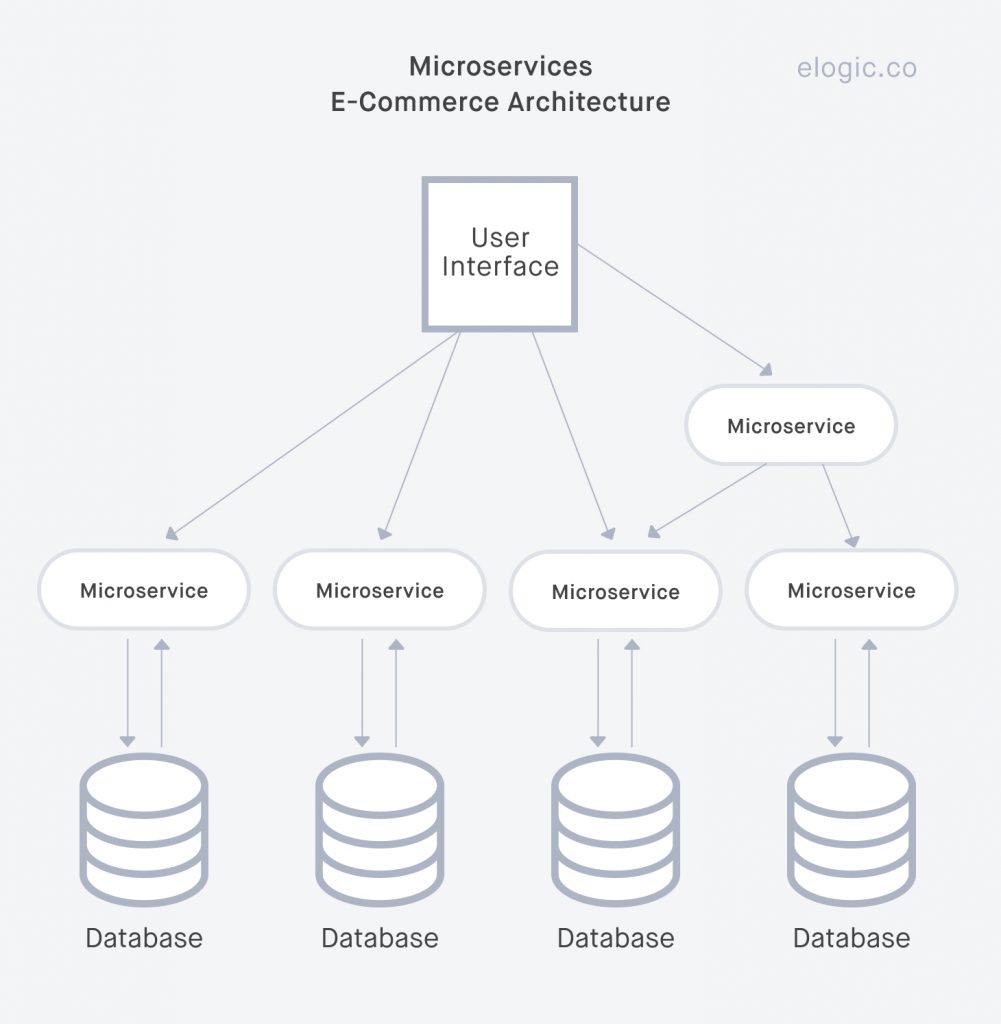
commercetools is a prime ecommerce microservices example of a company that implements this approach to creating ecommerce platforms and tools. Magento (aka Adobe Commerce) is currently in the process of redesigning its architecture and on a path to dropping the monolithic approach. The introduction of service contracts in Magento 2.0 is the first step towards this isolation.
Read more: commercetools Pricing: Why commercetools May Eventually Lower Your TCO
Here’s an ecommerce platform architecture diagram based on Magento microservices:
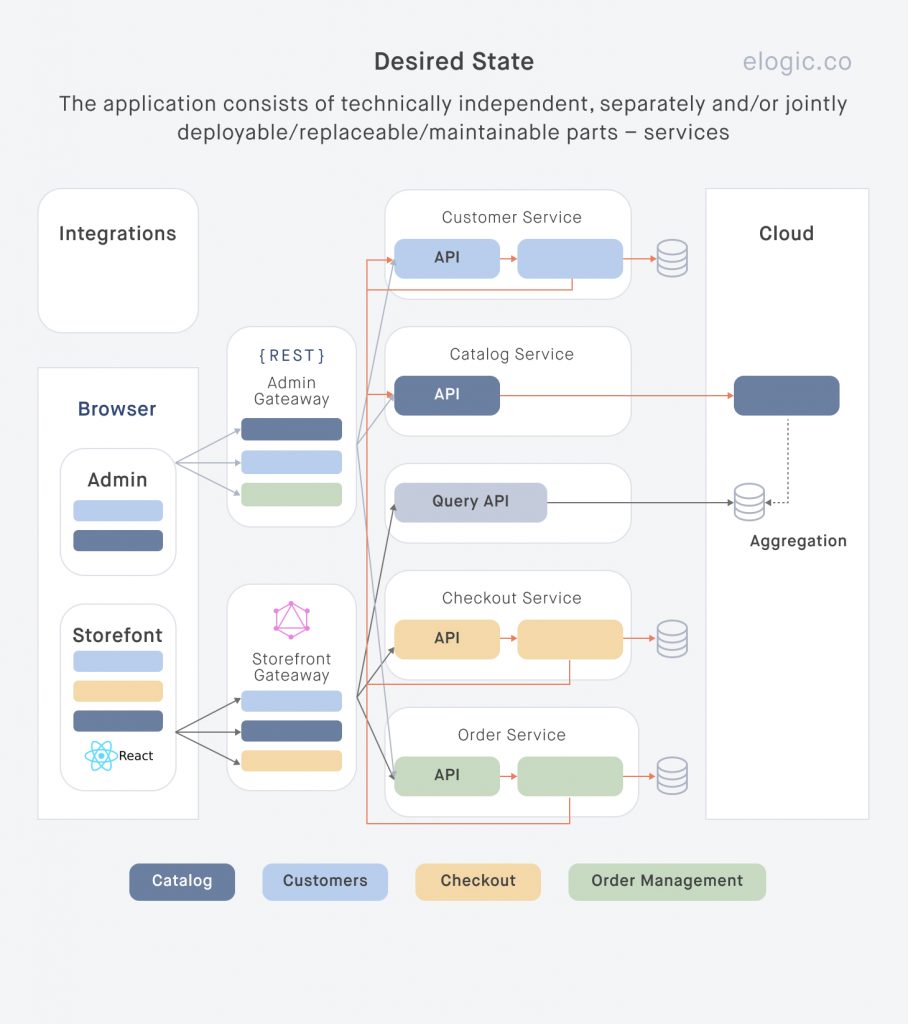
While microservice-based ecommerce architecture and system design seem to be a perfect choice for enterprises, it’s not the best option for startups due to the maintenance complexity. Look at the pros and cons factors.
| Pros of microservice architecture | Cons of microservice architecture |
| — Fault isolation (the error of one module won’t affect the whole system) | — Complex server communication |
| — Flexibility when it comes to choosing the new technologies (avoiding vendor lock-in) | — More resources are needed for data management |
| — Fast deployment due to smaller scope and codebases | — Reduced automatic testing option |
| — Easy scalability of any component without affecting others | — More logs to go through when debugging |
| — Option to debug locally |
Microservice architecture forms the basis of headless commerce. Read more in a related article: Best Headless Ecommerce Platform — Full Guide
Let’s say you decide to improve your ecommerce architecture. Is there anything you can do besides contacting an experienced solution architect that would deal with the technical stuff? Actually, a lot. Here are a few Elogic tips on how to boost your website today!
Ecommerce Architecture Tips to Boost your Website
Architecture of ecommerce might involve the hardcore tech part, but it’s also about the content and its structure on the website. Here are six DIY tactics for optimizing your ecommerce search architecture we recommend.
Map and Incorporate Your Target Keywords
The content of your platform draws the attention of your clients but also — of search engines (SEs). The latter shows your page in search results when someone is looking for the product you sell. This is why it’s important that you help the SEs discover, index, and rank your ecommerce website fast. Keywords do this job, so defining, grouping, and distributing them across the website is the first step to take.
Best practices:
- Create a spreadsheet with columns to represent the website pages
- Map keywords to relevant pages, URLs, titles, headings, and content (up to 2 KW for each)
- Optimize HTML elements, content, and links with relevant keywords. Make sure they are to the point and organically fit.
Take Advantage of Internal Linking
Internal linking connects two relevant pages/products/publications by hyperlinks. This technique allows you to improve the client’s experience and present more products related to the search without interrupting the buying process. It also has the following benefits:
- It makes the site navigation easier
- It encourages the users to stay on your website longer
- It helps them discover more about your services/products
- It facilitates the SEs to index the site and determine whether it relates to the query that one just typed in the search bar.
Schematically, internal linking on your homepage should look like this:
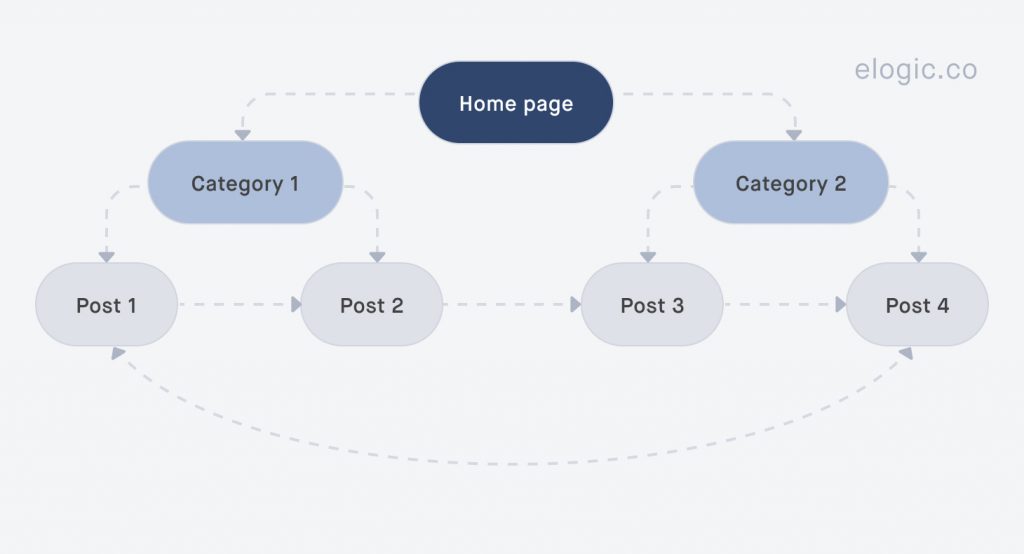
Using the links and labeling them correctly can boost the performance of the website online and include more keywords to get the attention of the SEs. But don’t abuse it to not end up as a spammy website.
Read also: 10 Best Ecommerce Website Design Ideas
Work on Intuitive Website Navigation
If the customer can’t find a button or menu they need, there’s a high chance they’ll just close the tab without returning ever again. But you can prevent it by creating intuitive site navigation. How to do it?
Add sidebar, footer, main navigation menu, breadcrumbs, and “to the top/down” buttons to ease the search of the product/category/action. Navigation keywords are similar across the apparel stores, so to be ranked higher and shown to a particular target audience, you need to use branded keywords.
Here’s how it looks in the case of Elogic’s client, Carbon38:
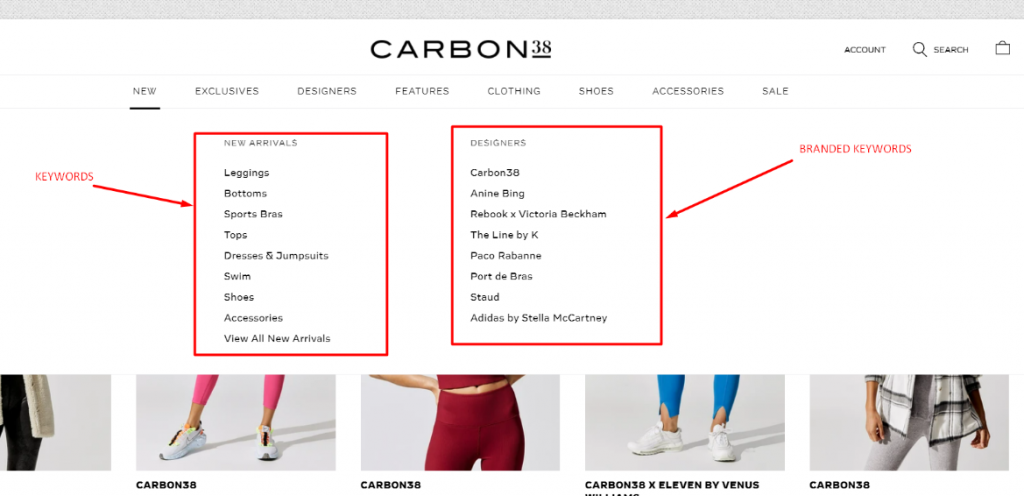
Optimize Your Product & Category Pages
Product and Category pages are the core of any ecommerce architecture design. The client should have zero issues with looking for an item they need, especially if the product they’re looking for has plenty of variables such as size, brand, price, etc.
For example, here’s how Elogic’s client, Amsale, has structured its product and category pages.

You can see how we organized the categories and made it up to the customers to sort and filter what they’re looking for. Meanwhile, they always have a navigation bar to explore other options.
Use Breadcrumbs
From general to more specific — this is the logic of navigation links known as breadcrumbs. Labeling them correctly will help your readers to know where they are on the site, jump back and forth between the categories, and help the SEs understand what’s located on the pages.
This is the ecommerce website structure Elogic offered Benum, an international distributor of audio equipment.

When reviewing a product, the client has the whole row of categories and subcategories that led to this product. Should they need cords to the microphone or compare it to another model, they won’t need to return to the home page and do the search again — they can do it in one click.
Read more: How to Conduct an eCommerce SWOT analysis
Dive Into Product Image Optimization
It’s not only the name of the product — the best architecture for ecommerce sites also involves the right image size and alternative text if the website is used by people with limited vision/hearing abilities. The basic rule is to keep image naming as close to the potential search query as possible.
Read more in our related article: Magento 2 Image Optimization: Complete Guide & Best Practices
Wrapping Up
Planning an efficient eCommerce website architecture that enables the best performance of the platform is vital to providing the best value to your customers. It will also increase the website’s visibility for the search engines that process the search queries, as well as get you higher SERP rankings.
Elogic solution architects are here to choose the most appropriate ecommerce application architecture for your business model, budget, and future strategy.
Delegate ecommerce website architecture to professionals at Elogic
Hire a solution architect nowFAQs
How to create a website architecture for ecommerce sites?
The best way to create an ecommerce technical architecture that lasts is to hire a solution architect. It’s important to create a coherent and cohesive structure for your store that no third-party integration can shatter or slow down in terms of performance.
What is ecommerce enterprise architecture?
Enterprise architecture in ecommerce implies a map of IT assets that interact following certain governing principles to streamline business processes. Oftentimes, it concerns wholesale B2B retailers and the complexity of their business models, so their B2B ecommerce solution diagram may consist of the core product code and third-party systems, like ERP, CRM, payment gateways, etc. connected to this core via API.
How to develop a scalable ecommerce architecture?
First and foremost, you need to choose a flexible ecommerce platform that will allow upscaling and downscaling according to your needs. Second, you need to hire a professional ecommerce agency that will map out the logic of your store and provide a future-proof solution for your business.
FAQs
How to create a website architecture for ecommerce sites?
The best way to create an ecommerce technical architecture that lasts is to hire a solution architect. It’s important to create a coherent and cohesive structure for your store that no third-party integration can shatter or slow down in terms of performance.
What is ecommerce enterprise architecture?
Enterprise architecture in ecommerce implies a map of IT assets that interact following certain governing principles to streamline business processes. Oftentimes, it concerns wholesale B2B retailers and the complexity of their business models, so their B2B ecommerce solution diagram may consist of the core product code and third-party systems, like ERP, CRM, payment gateways, etc. connected to this core via API.
How to develop a scalable ecommerce architecture?
First and foremost, you need to choose a flexible ecommerce platform that will allow upscaling and downscaling according to your needs. Second, you need to hire a professional ecommerce agency that will map out the logic of your store and provide a future-proof solution for your business.


